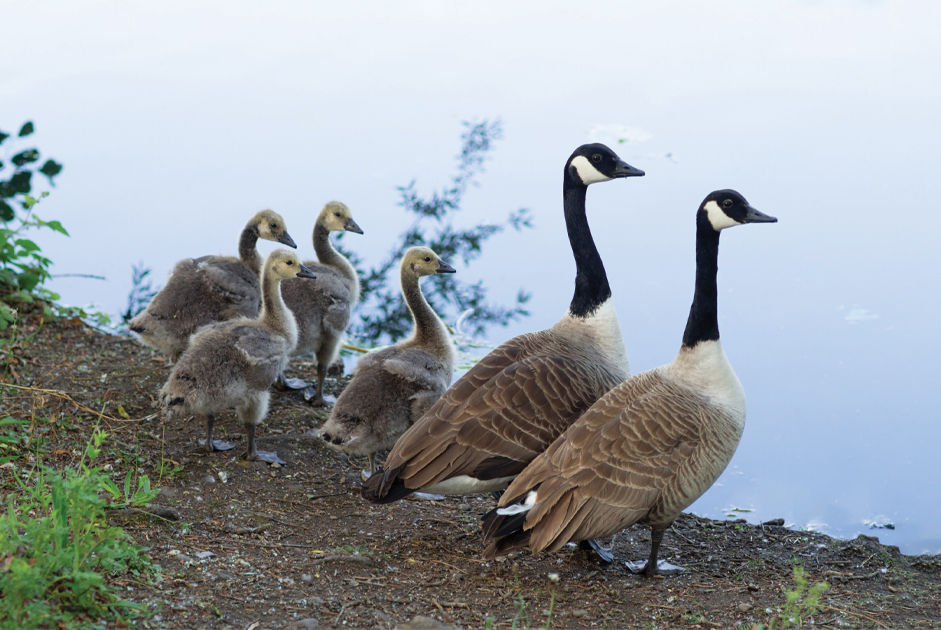One of my first memories as a very young child is of my father, taking me to Lake Ontario in Toronto, where we lived at the time, to see the Canada geese. This place was famous for, among other things, being the site where Babe Ruth hit his first homerun ball into its aquamarine depths. Dad told me that these birds always fly in the shape of a “V” and that, when the goose in the lead gets tired, another goose magically takes over the position. He spoke alternately in Polish and in broken English and, right at that moment, a skein of geese flew overhead, honking loudly, black/brown feathers gleaming with the signature white chin straps visible on their faces, as if to confirm the truth of his comment. Years later, now living in North Carolina, I still love these birds and sing their praises.
On a recent trip to Kernersville – where many people recently have been flocking to live – I was thrilled to see a pair of these birds – the largest waterfowls around (with the exception of swans) seemingly flocking there, as well. I know from my readings, as an armchair ornithologist, that, although they are waterfowl, they spend most of their time on land. What I didn’t expect to see was the goose and gander (female and male) tending to a nest at the Pinnacle Bank parking lot on a small perimeter of land beneath a large sign which said “do not enter” (a plea to car traffic which may have accidentally proceeded in the wrong direction). I couldn’t help but laugh at their apparently intelligent choice of a safe area, away from human machinations.
As luck would have it, I had just purchased a bag of wild bird seed at a local store. As I got out of my car, a huge cup of it in hand to throw to the engaging couple, the male suddenly flew at me, flapping its wings wildly and making angry hissing sounds. I jumped back into the Toyota, my heart pounding, startled by the attack which took no account of my good intentions. The female rose from the nest, and I could suddenly see it was feathered with down and host to four perfect white eggs. A moment later, the couple eagerly devoured the evening repast I had provided.
Taking a few photos, I went to the library next door and began reading about Canada geese and learned the following:
According to the “Four Paws International” website, Canada geese are highly social animals which reside in every state, breeding in Canada and the northern U.S. in a wide range of habitats. They eat seeds, nuts, grass, plants and berries, mate for life and are very protective of their partners and offspring. They work in tandem to build their nest, collecting twigs, bark and leaves. Both parents raise their offspring which remain with them for about 12 months, traveling together over long distances (up to 1,500 miles) in large flocks of family groups. Dr. Konrad Lorenz, an animal biologist, noted that geese possess a veritably human capacity for grief, expressing a “mourning behavior” when they lose their mating partner or their eggs. That includes hanging their heads dejectedly, appetite loss and indifference to environmental stimuli. Seems that we are not the only sentient creatures who grieve when our soulmates are lost. When migrating, if one Canada goose becomes injured or sick, two companion geese will immediately accompany him or her to the ground and not leave until the bird either recovers or dies. This example of animal compassion suddenly put tears in my eyes because I saw there was no other explanation for it – but that.
Besides being beautiful birds, they are also really important ones. They play a critical role in environmental betterment by dispersing seeds (of consumed fruits and berries) and then depositing them in feces which enrich the ecosystem by nutrient inputs. The goose feces contribute to soil fertility and operate as prey items for several predatory species such as raptors, foxes and snakes. The great American naturalist James Audubon threw more praise in their direction, describing them as courageous, loyal, devoted and fierce in the protection of their families.
Months later, I returned to Kernersville and saw the parents ensconced on the bank lawn with their four new goslings. Quietly placing a platter of cracked corn nearby, I remembered at that moment the words of English poet W.H. Auden: “I’ll love you til the ocean is folded and hung up to dry/And the seven stars go squawking/Like geese about the sky.” And, I recalled my immigrant father who, like me, carried a love for these creatures, memorializing them in photos for his daughter who grew up in two lands.


















